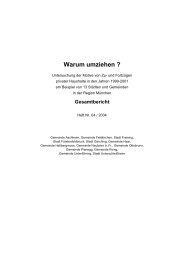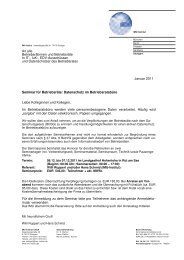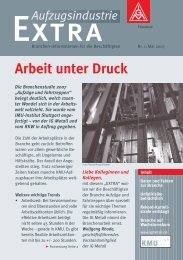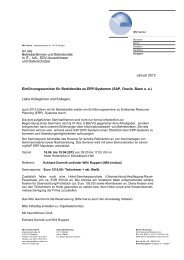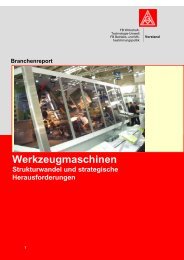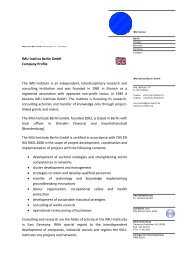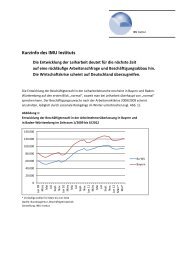Aufzüge und Fahrtreppen - IMU Institut
Aufzüge und Fahrtreppen - IMU Institut
Aufzüge und Fahrtreppen - IMU Institut
Erfolgreiche ePaper selbst erstellen
Machen Sie aus Ihren PDF Publikationen ein blätterbares Flipbook mit unserer einzigartigen Google optimierten e-Paper Software.
order to withstand the growing competitive<br />
pressure. Standardization and modularization<br />
will also remain decisive topics,<br />
although these should not be pursued at<br />
the expense of individual solutions and<br />
fl exibility; the aim here must be to implement<br />
challenging and qualitatively superior<br />
concepts. A factor of particular signifi -<br />
cance is the on-going transformation in<br />
the service sector, where the pressure to<br />
implement change may be expected to<br />
affect the type of work to be performed,<br />
waiting times, work facilities and also the<br />
self-image of installers. In terms of employment,<br />
there is every reason to fear a<br />
further move away from the classic normal<br />
employment relationship, with unsecured<br />
employment concepts involving<br />
contract work and outsourcing shaping<br />
the nature of employment policy in the<br />
future.<br />
This development will entail employment<br />
risks in two different ways: Quantitatively<br />
speaking, the risks inherent in the employment<br />
situation in the industry will<br />
culminate in further job cuts in production,<br />
administration and servicing as a result<br />
of outsourcing, relocation abroad,<br />
streamlining and work intensifi cation.<br />
Further acquisitions by the main players<br />
entail the risk of further radical cuts to an<br />
already exorcised production workforce<br />
in the acquired companies. In qualitative<br />
terms, the result will be increased severity<br />
in terms of working conditions for employees,<br />
and further polarization into<br />
highly qualifi ed positions which will con-<br />
tinue to be remunerated as before and<br />
simpler posts which will be classifi ed lower<br />
down the scale. The tendency in both<br />
production plants and in the service sector<br />
is already refl ecting this development.<br />
More widespread use of contract working<br />
arrangements will place permanently<br />
tenured workforces <strong>und</strong>er even greater<br />
pressure.<br />
Appraisal of the current economic situation<br />
and the outlook for continued economic<br />
development by those questioned<br />
as part of the industry survey is f<strong>und</strong>amentally<br />
positive. One representative of<br />
the lift constructor SME sector reported a<br />
“superb order book situation” in 2006,<br />
describing his company’s struggle to adhere<br />
to delivery dates and keep up with<br />
prompt installation of new lifts. Alongside<br />
the gratifying order volume, the profit<br />
situation in the industry has also taken<br />
a turn for the better.<br />
The improved competitive situation<br />
means that moderate price increases for<br />
new installations are now once again on<br />
the cards. Although competition is still<br />
described as tough, prices are on the<br />
move again to a certain degree due to the<br />
current shift in the ratio of demand to<br />
supply. But (according to a questioned<br />
trade expert): “There will not be a return<br />
to the pricing levels we were able to command<br />
in the past. There are still a number<br />
of black sheep who try to <strong>und</strong>ercut by 20<br />
to 30 % below our tightly calculated contribution<br />
margin!” The moderate price<br />
rises have been fl anked by exorbitant in-<br />
creases in the cost of materials (by 100 %<br />
for some types of stainless steel). Whether<br />
or not the current high demand for<br />
lifts and the positive order book situation<br />
are likely to endure for the medium-term,<br />
or are just a fl ash in the pan in the wake<br />
of a building activity boom will depend<br />
largely on further developments in the<br />
building industry and also on the degree<br />
to which the industry is able to market<br />
the lift as a value-enhancing investment<br />
in the property market.<br />
Bibliography<br />
Bernard, Andreas (2006): Die Geschichte des Fahrstuhls.<br />
Über einen beweglichen Ort der Moderne.<br />
Frankfurt.<br />
Dispan, Jürgen (2007): <strong>Aufzüge</strong> <strong>und</strong> <strong>Fahrtreppen</strong> –<br />
Branche im Wandel. Untersuchung zur Situation<br />
<strong>und</strong> Entwicklung der Branche <strong>Aufzüge</strong> <strong>und</strong> <strong>Fahrtreppen</strong>.<br />
Branchenreport. Frankfurt, Eschborn (Download:<br />
www.imu-institut.de).<br />
Dresdner Bank (2007): Branchen-Report Hebezeuge<br />
<strong>und</strong> Fördermittel (WZ-Nr. 29.22). Frankfurt.<br />
Iwer, Frank (2000): Innovationstrends in der Aufzugsindustrie<br />
<strong>und</strong> Folgen für die Beschäftigungssituation.<br />
Projektabschlussbericht (<strong>IMU</strong> <strong>Institut</strong>e,<br />
commissioned by IG Metall as part of the cooperation<br />
project RKW-DGB). Frankfurt.<br />
Mihm, Andrea (2005): Die Rolltreppe. Kulturwissenschaftliche<br />
Studien zu einem mechanisch erschlossenen<br />
Zwischenraum. Marburg.<br />
Schmitt, Johannes (1988): Entwicklung der Aufzugbranche<br />
von der Warenproduktion zum Dienstleistungsanbieter.<br />
Frankfurt.<br />
Thews, Udo (2004): Fachbegriffe der Aufzugstechnik.<br />
Part 1. Norderstedt.<br />
38 LIFT-REPORT 33. Jahrg. (2007) Heft 6



